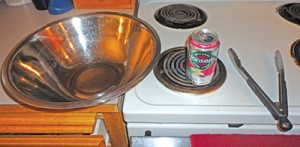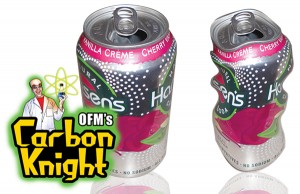Simple Science Experiments: Crush A Can With The Force Of Air Pressure
Crushing a can? Just with air pressure? Science CAN be fun! This simple science experiment is really cool but requires some safety measures to get it done right. Since the use of a stovetop electric burner (or gas alternative) is necessary, this is a parent-assisted project. Children should not attempt this experiment without parental supervision!
 Materials
Materials
- Several empty and clean soda cans
- Electric stove (or gas stove alternative)
- Metal tongs
- A large bowl
- Ice cubes
- Water
Procedure for an electric stove top
- Fill the bowl with icy water. Use enough water and ice to cover at least half of the can. Place beside stove.
- Practice picking up and holding the soda can with the tongs. Try grabbing the can near the bottom.
 Rehearse setting the can “open end” into the bowl of water in one quick motion. This is the method you will use to ensure a ‘crush’ and, of course, you want to get it right!
Rehearse setting the can “open end” into the bowl of water in one quick motion. This is the method you will use to ensure a ‘crush’ and, of course, you want to get it right!- Put two tablespoons of water into the clean soda can.
- Turn on electric stove to high heat (choose a front burner).
- Put the can directly onto the electric coil (yes, the can will be ok…it will not burn).
- Leave the can on the burner until you see steam coming out of the top for at least a minute.
- Using the tongs, grab the can near the bottom and with one swift move, turn it over so the open end goes into the icy bath.
Procedure for a gas range
- Execute all of the above steps with the exception of step #6 (can on electric coil). Instead, use a pan with a little bit of water in it. Place the soda can into the water bath (covering just the bottom inch of the can).
- Let the water boil (as stated in step #7 above); but realize this process will take much longer to heat up as opposed to putting the can directly on the electric stovetop.
- Then, proceed with step #8.
Explanation
The moment the can collapses in on itself is one of the best demonstrations because it is a little startling at first, but is a pretty effective experiment! A few principles are working here: First, you are boiling the water in can, which turns it into a gas. Important to note is that the gas (steam) is taking up a lot more room than the liquid form of water (gas expands when it turns from a liquid). So, if you were to cool that steam, it would shrink into a liquid. Hold onto that thought….
Second, you need to know that nature doesn’t like a vacuum or a lack of air. It tries to fill it up. It’s like when you use a plunger on the floor ─ you first push out all the air and then it “sticks” onto the floor. Air is trying to get into the plunger, but it can’t so it makes a “suction.” Ever try to stick a cup to your mouth? You suck out the air and then it sticks to your face, right? Please try this if you haven’t, you don’t want to miss out on a big part of childhood laughs!
What’s the big picture here? Air goes from high air pressure to low air pressure (or more air to less air). If something gets in the way, it makes a push. So how does this relate to the crushing can? The steam pushes out all the air in the can; you noticed steam coming out? It just pushed out all the air. When you quickly move the can to the icy water, it immediately cools the steam, turning it into water (and thus, it shrinks doing so). This also means NO AIR is in the can! It is a vacuum. And so air outside tries to get into the can and the only way how is to crush the can to do so. It also pushes some water into the can. Confusing? Just read it again, email your questions to Orlando Family Magazine’s Carbon Knight (steve.davala@gmail.com), or maybe just crush another can…
Since science CAN be fun, do you want to experiment further? How does the size of a can affect this project? How about changing the amount of water in the can? Just be sure to be extremely safe and always with parental guidance!
Steve Davala is a middle school science teacher who likes to write and work with Photoshop. He has two kids who serve as guinea pigs for these simple science experiments. Learn more at www.stevedavala.com.









